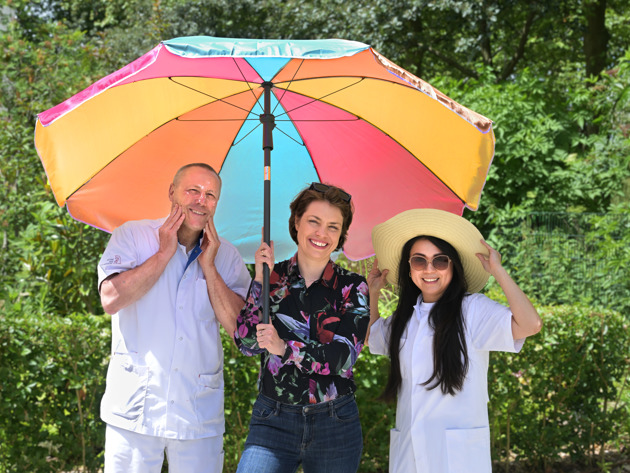Safe in the sun: prevent skin cancer
1 May 2024 09:00
Skin cancer is the most common form of cancer in the Netherlands. The main cause of skin cancer is UV radiation. That’s why it’s important to protect yourself from the sun. On this page, you’ll find out what you can do today to help prevent skin cancer.

Together against skin cancer
Our mission: to help all Dutch citizens make more conscious, informed, and safe choices when it comes to sun exposure. Together, we’re building a movement in the fight against skin cancer!
UV Index 3 or higher: Seek shade, slip, slap, slide & slop
From a UV index of 3 and above, there’s already a risk of skin damage if you go outside unprotected. That’s why it’s important - especially in spring and summer (from April through September) - to check the UV index before heading outdoors. If the UV index is 3 or higher, we recommend: seek, slip, slap, slide & slop.
-
Seek
Seek shade whenever possible, especially between 12 - 15 hrSlip,
-
Slip, slap, slide
Slip on a shirt, slap on a hat and slide on some sunglasses
-
Slop
Slop on sunscreen (and use at least SPF 30)
Facts and myths
There are many claims about how skin cancer develops and how best to protect yourself against it. We've listed the most common ones and checked them with dermatologist Elsemieke Plasmeijer.
General information
Every time you get sunburned, you increase your risk of skin cancer.
Fact: "Even a single severe sunburn during childhood already increases your risk of developing skin cancer later in life."
People with fair skin and many moles have a higher risk of skin cancer
Fact: "That’s true — but these risk factors can be misleading. People who burn easily often know this and take precautions. Those who don’t burn (as quickly) may unknowingly accumulate significant sun damage. People with many moles (more than 100) have a higher risk of developing melanoma."
Shade, protective clothing, and sunscreen together provide the best protection.
Fact: "Sunscreen alone is not enough. Combine measures for optimal protection. That’s why, from a UV index of 3 and above, the recommendation is: Seek, slip, slap, slide and slop.
Seek
You can’t get sunburned in the shade.
Myth: "Up to 50% of UV radiation can reflect off surfaces like sand, water, or walls, and still reach you."
You shouldn’t sit in the sun between 12:00 and 15:00.
Fact: "During these hours, the sun is at its highest point, and the risk of getting sunburned is greatest. It's best to avoid the sun during this time."
You can't get sunburned on cloudy days.
Myth: "Even on cloudy days, you can still get sunburned. The UV index might be lower, but UV rays can still penetrate the clouds and damage your skin. That’s why it's important to apply sunscreen regardless of the weather."
Slip, Slap, Slide
Clothing protects better than sunscreen.
Fact: "A tightly woven fabric, hat, and sunglasses provide physical protection that doesn’t wear off like sunscreen does."
A t-shirt always provides enough protection against the sun.
Myth: "Not every T-shirt offers sufficient protection against UV radiation. Thin, light, or wet T-shirts can allow many UV rays to pass through. There is special UV-protective clothing with a higher protection factor (such as SPF 50+)."
Dark clothing provides better protection against UV radiation than light clothing.
Fact: "Dark, tightly woven clothing offers the best protection against UV radiation, even though it may feel warmer. Light clothing is airier but allows more UV rays to pass through."
Slop
SPF 50 means you can sunbathe 50 times longer.
Myth: "For this effect, the sunscreen would need to be applied so thickly that a visible white layer forms on the skin, which no one does. A higher SPF does mean better protection, but you still need to reapply every two hours—especially after swimming or sweating."
Sunscreen lasts for a year.
Fact: "Sunscreen can be used up to a year after opening. However, a year after opening, or if the bottle has been exposed to significant temperature fluctuations, the sunscreen’s effectiveness decreases. So, don’t store the bottle for too long, and avoid leaving it in hot cars or direct sunlight."
A tanned skin doesn’t need sunscreen anymore.
A tanned skin is always damaged skin. You should always apply sunscreen with at least SPF 30, even if you are already tanned.
What is skin cancer?
Skin cancer is a disease in which some skin cells begin to grow uncontrollably and behave abnormally. These cells eventually form a tumor. Skin cancer typically develops due to DNA damage in skin cells, often caused by UV radiation from the sun.

About the UV index
What Types of Skin Cancer Are There?
There are different types of skin cancer, some of which are more common than others. The three most common types are:
Basal Cell Carcinoma (BCC): A basal cell carcinoma usually begins as a pink, skin-colored, or light brown bump that grows larger, sometimes with a crust in the middle. It may also look like an eczema spot that doesn’t go away.
Squamous Cell Carcinoma (SCC): A squamous cell carcinoma typically appears as a light pink bump that grows slowly, a scaly spot, or a small wound that enlarges.
Melanoma: A melanoma is identified by (mole) spots that change in size, color, or appearance. However, in half of cases, it develops as a new spot on the skin, not from an existing mole.
The Main Risk Factors for Skin Cancer
UV Radiation
Excessive sunlight is the main cause of skin cancer. UV radiation from tanning beds is also harmful. The more UV radiation your skin has been exposed to, the higher the risk.
Genetics
Having many moles (more than a hundred) increases the risk of melanoma. Some forms of skin cancer are hereditary.
Skin Type
People with fair skin (skin type I or II) are more sensitive to UV radiation. The sun is more harmful to them than to people with darker skin.
Age
The risk of skin cancer increases after the age of fifty. Basal cell carcinoma and squamous cell carcinoma are more common in this age group. However, melanoma can also occur at a younger age.
Medications
Medications that suppress the immune system, such as those taken after an organ transplant, increase the risk of skin cancer.
How to Recognize Skin Cancer
Skin cancer is usually recognized by a spot on the skin that suddenly appears or changes. A melanoma can be identified by (mole) spots that change in size, color, or appearance, but in half of the cases, they develop as new spots on the skin, not from an existing mole. “Self-examination is therefore very important, although it can sometimes be difficult to distinguish moles from age spots or skin tags,” says Plasmeijer. You can use the ABCDE method (see below) to check whether you might have a melanoma. If in doubt, visit your doctor.
Asymmetry: The spot is asymmetrical in shape or color.
Border: The spot has irregular edges rather than a smooth, round shape.
Color: The spot changes color.
Diameter: The spot has a diameter of more than 5 mm.
Evolving: The spot changes, itches, or bleeds.
Pay attention to the "ugly duckling" among the moles
If you have many moles, pay extra attention to the ones that stand out. The so-called "ugly duckling" is a mole that is different from the rest—similar in some ways but deviating in shape, color, or size.
A mole that changes, starts itching, or begins to bleed could also be an "ugly duckling."
If you notice any abnormalities in moles, make an appointment with your doctor.
 nl
nl